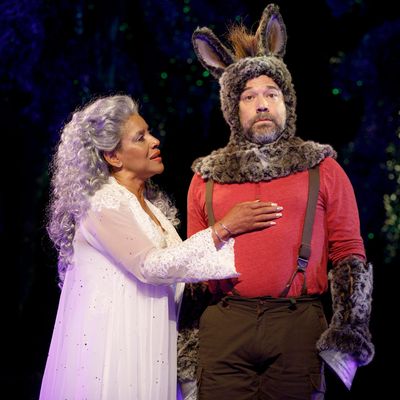
When I was a kid, I had a friend who loved icing but hated cake. At her birthday parties, I would sit at the table with a bunch of other slightly uncomfortable elementary-school girls, while her mother lovingly served her a cardboard box covered in frosting and the rest of us just … watched her enjoy it.
I had an uncannily similar feeling as I sat in the audience for A Midsummer Night’s Dream, the Public’s current Shakespeare in the Park offering at the Delacorte Theater. As directed by Lear deBessonet, this Midsummer is not so much play as pageant, a Technicolor mishmash of styles, gestures, sounds, and ideas that, for the most part, have little discernible relation to one another. A Midsummer Night’s Dream is in there somewhere, but Shakespeare’s play might as well be a cardboard box: the creative team doesn’t seem to trust that they are in fact dealing with a multi-textured and wonderful recipe. Instead, they’ve gone for sugar flowers.
Of course, icing tastes good. It’s sweet and fun to look at. And as I listened to audience members around me laughing at the production’s myriad gags and gimmicks (we’re talking blow darts and whoopee cushions here), I couldn’t help feeling like a bit of a killjoy.
After all, in the words of Sheryl Crow, if it makes you happy, it can’t be that bad … Or can it? Here’s the thing: There are plays that are, in essence, pure, delightful fluff — plays that don’t need to be taken to task for not providing ballast. But for all its charm, A Midsummer Night’s Dream doesn’t have to be one of them. There is a there there. And it’s angrier, dirtier, sexier, and therefore much, much funnier than the glitter-bomb that’s currently exploding at the Delacorte.
In a recent Times piece, Alexis Soloski talks to the actors playing Midsummer’s four young lovers about the tricks and trials of creating chemistry onstage. Alex Hernandez, who plays Demetrius, admits that his performance is “way more family-friendly than how I live my life … my actual sort of carnal appetite isn’t what’s necessary.” But it is! It’s exactly what’s necessary! Sex and violence are at the heart of Midsummer. “If thou follow me, do not believe / But I shall do thee mischief in the wood,” Demetrius threatens Helena. The fairy king Oberon, engaged in a possessive squabble with his queen Titania, vows to bewitch her with a magic herb that will “make her full of hateful fantasies” (Soloski gets flak in the comments section of her article for calling this potent little plot-device a “botanical date-rape drug,” but she ain’t wrong.) And when the fairy queen is bewitched into falling for the rude mechanical Nick Bottom (after the goblin Puck has transformed him into part-donkey), her libido launches into full-on pathetic fallacy mode: “The moon methinks looks with a watery eye … Lamenting some enforcéd chastity.” Even the moon wants to get down, and Titania is certainly about to.
To his credit, Danny Burstein as Bottom registers something of this line’s breathtaking sensuality in his response, but not because Titania (Phylicia Rashad) puts much into her delivery. No one does. Desire — its thrill and its frustration — is athletically played at in this Midsummer but never really registered on a gut level. The lovers (Hernandez, Annaleigh Ashford as Helena, Shalita Grant as Hermia, and Kyle Beltran as Lysander) are all charming actors who handle the text with relative dexterity (though Ashford has a tendency to treat the language as Silly Putty, to be stretched and bounced for laughs rather than plumbed for true feeling). They throw themselves gamely into Chase Brock’s choreography, which sometimes looks like parkour-lite and sometimes like Looney Tunes, but they seldom convey any sense of real lust, real confusion, real danger. And there is danger here. Everyone’s lost in the woods in the middle of the night, and at least one woman is being pursued by two drugged men whose claims to love her are quickly going from romantic to monomaniacal. Taken to its logical extreme, this situation will not end well. It doesn’t come to actual violence in Midsummer, but it could. And that’s why the humor is so explosive — it’s being held in brilliant balance with something very scary indeed.
Lear deBessonet is not the first director to sanitize A Midsummer Night’s Dream, to highlight all that is bright and shiny about it, and she won’t be the last. It’s a perpetual doom for this play, perhaps because we’re taught it in grade school, perhaps because of its often rhyming poetry, perhaps because of the fairies.
About the fairies: Like the witches in Macbeth, they’re a big sticky question that needs answering (the supernatural is hard!). What will a director do with them? DeBessonet’s answer is, frankly, baffling. This Midsummer’s fairy court is an ensemble of senior citizens: Titania, Oberon, Puck, and the rest of the pixies are all played by actors over 60, first in white pajamas and then in glitzy black evening dress. Their age is set off by the contrast to the Changeling boy (the very young Benjamin Ye) who cavorts among them wearing flowers, the innocent crux of Oberon and Titania’s feud.
I spent every one of the fairies’ scenes puzzling over their visual vocabulary and how it related to, well, anything else in the production. Pajamas, okay. So … sleep, dreaming … Yes … And? Maurice Sendak and Little Nemo in Slumberland floated through my head, and while I would have been fascinated by a production that dove headlong down that rabbit hole, this was not that Midsummer. Rather, these fairies shuffled through an environment that could have been the set for any production of A Midsummer Night’s Dream, or, for that matter, Into the Woods. What do scenic designer David Rockwell’s mossy trees full of twinkle lights and curving palace walls have to do with Puck’s PJs? What do Puck’s pajamas have to do with the lavish series of costumes worn by Theseus and Hippolyta, including period hunting garb in psychedelic camo prints and gold bedazzled wedding outfits that look like they came from the closets of Beyoncé and Louis XIV? (Clint Ramos’s costumes are an expensive looking hodgepodge seemingly bound together by nothing other than the old directive from The Producers: Keep it light, keep it bright, keep it gay!) What does the dead wolf prop carried on by Theseus and promptly abandoned in the play’s first scene have to do with … anything?
The production is not without fun — it just feels rather desperate to ensure that you are in fact having fun every minute. It’s a Midsummer with host anxiety. And there’s nothing more telling than the fact that the majority of laughs come not from Shakespeare but from little interstitial bits — improvs and visual gags and winks in the audience’s general direction. Not that improvisation can’t work in Shakespeare: It can, but only if the the text itself feels equally immediate and vital. Here, the text feels secondary, as if director and team don’t fully trust that it’s anything more than a rack on which to hang some pretty clothes.
As actual confetti exploded across the stage near the play’s finale, I found myself mentally moving on from The Producers to another snatch of classic Broadway cleverness: “Give ’em an act with lots of flash in it, and the reaction will be passionate.” Chicago’s Billy Flynn was right — it is hard to see when your eyes are full of sequins. And it’s hard to taste Shakespeare’s nutty, layered cake when your mouth is full of icing.
A Midsummer Night’s Dream runs at the Delacorte through August 13.





